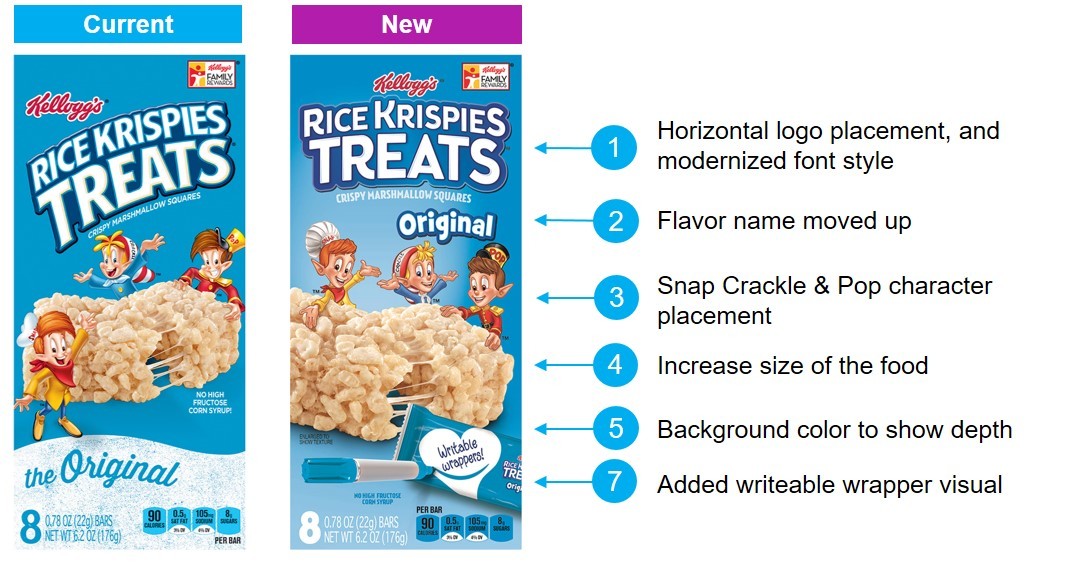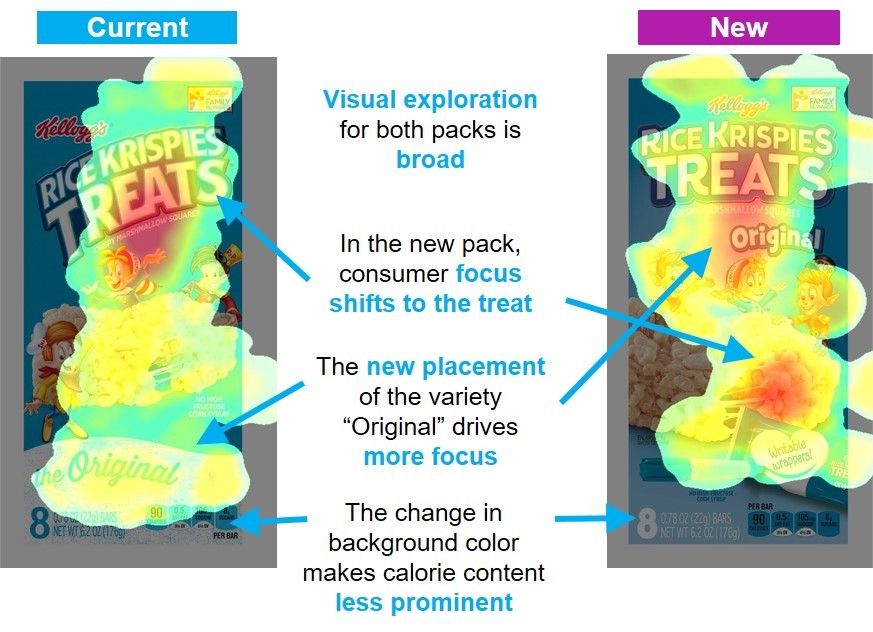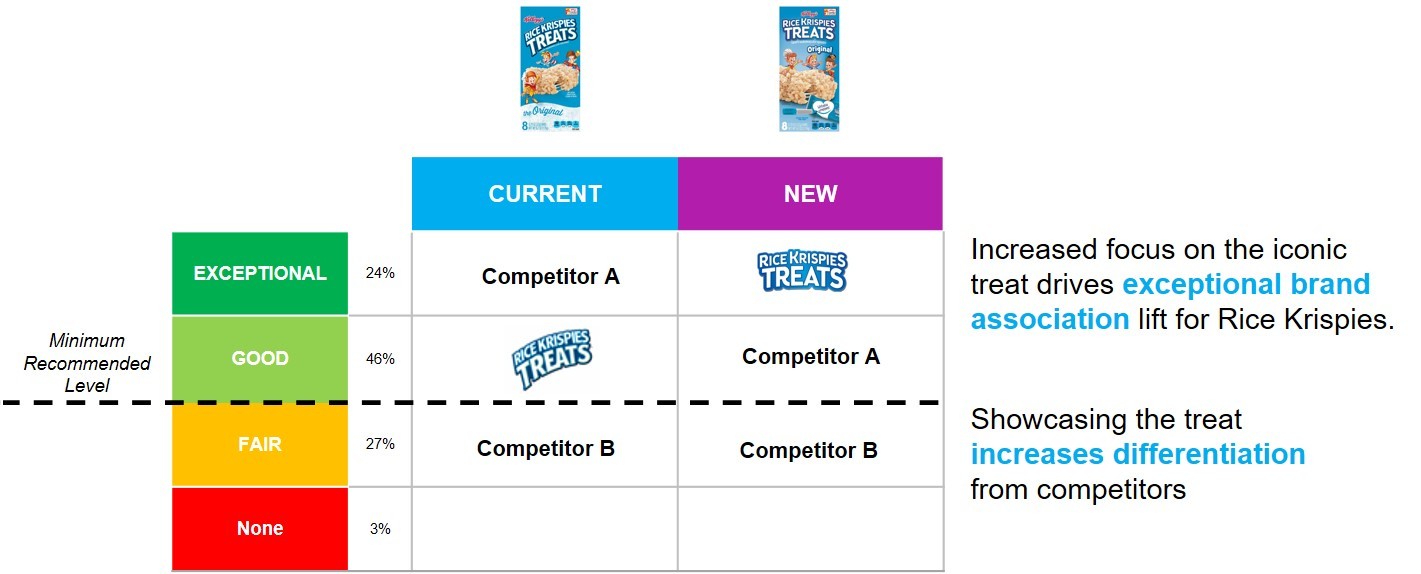Rice Krispies Treats: Positively Influencing Consumer Purchasing Decisions In-Store
One of Kellogg’s top-selling snack brands, Rice Krispies Treats, has seen continual growth over the last five years, with a 6.0% annual growth rate. However, much of the brand’s growth has come from increased distribution, both in number of stores selling and number of items carried, which has a natural ceiling.
The brand faces fierce competition in the Snack Bar category with heavy-hitting rivals and new category entrants – category innovation doubled between 2012 and 2016. Promotion saturation in the category has led to high brand switching and low loyalty.
Kellogg hoped to positively influence consumer purchasing decisions in-store by refreshing their packaging to communicate brand equities of “fun” and “sharing”, drive desire by focusing on the food, and differentiating from competitors on shelf.
Kellogg made several changes to the Rice Krispies Treat package design, including orientation and font style of their logo, refreshing the Snap! Crackle! Pop! iconic characters, placement of the variety/flavor description, background color, and an increase in the image size of the food. Kellogg’s package redesign would extend to all sizes of the Original flavor, creating a more consistent blue brand block that extends to the bottom shelf.

Approach
Kellogg collaborated with Nielsen Consumer Neuroscience to identify nonconscious consumer response to Rice Krispies Treat’s new packaging and on-shelf strategy in order to drive future growth:
- Is the new package design as effective as the current?
- Are branding perceptions positively impacted?
- Does the new design communicate all desired equities?
- Does the new package impact Rice Krispies Treats at shelf?
Nielsen used a combination of EEG and eye-tracking to measure consumer engagement with the new package design among parents and non-parents who had purchased the snack bar category in the past six months. Nielsen used two approaches for this study: measuring the package in isolation and measuring the package in its competitive context on shelf. By evaluating the package in isolation, Nielsen was able to uncover nonconscious responses to the package overall as well as to individual elements and provide cues to package performance drivers and areas for improvement. By evaluating the package on shelf, Nielsen assessed its ability to grab visual attention and differentiate from competitors.
With EEG, Nielsen was able to measure critical components of consumer engagement: attention processing, memory activation, and emotional motivation. Reading EEG-based responses to the brand and to competitors, pre-exposure and post-exposure to the package allowed Nielsen to understand how well the Rice Krispies Treats new package improved activation of the brand and key messaging, as well as brand saliency after exposure in the competitive context. Using eye-tracking, Nielsen was able to identify how consumers navigate the new package and where they visually focus and, combined with EEG, provide deeper understanding of how individual and grouped elements on the package are working together.
Results
Package in isolation:
Eye-tracking results showed that while both packages are broadly visually explored, there are notable shifts in consumer focus: the new package shifts more consumer focus to the treat (the food image) and the flavor/variety messaging, while the change in background color makes the calorie content callout less prominent. EEG results show that the new package has strong action intent, a derived measure combining emotional motivation and memory activation, which has been validated to predict in-store sales. The new design maintains the strength of the current package among parents while performing directionally higher among non-parents, who are emotionally engaging with the new logo orientation and a larger image of the treat. This appeal to non-parents gives Kellogg an opportunity to expand their current consumer base (in 2016, more than half of households who purchased Rice Krispies Treats were households with kids). EEG results also revealed that the new pack leverages iconic brand assets, such as the blue and white color cues and animated characters, to drive exceptional brand associations for Rice Krispies Treats, providing differentiation from competitors. The new design also maintains brand perceptions of being a modern snack that can be shared with others.
Package in context:
Eye-tracking results show that visual focus is fairly consistent in both sets of shelves, with consumers exploring a similar set of products on the upper four rows. However, when we overlay eye-tracking with EEG engagement, we see visual navigation becomes simplified and more orderly when the new package is on shelf, driving a stronger emotional response with consumers as they recognize and focus on brands. Given the size and saturation of the snack bar category, this simplicity may help retailers provide a more pleasant shopping experience. Additionally, the Rice Krispies Treats package changes are driving higher overall memory activation for the shelf!


Conclusions
With the help of Nielsen Consumer Neuroscience, Kellogg was able to verify that the new Rice Krispies Treats package is strong and has key advantages over the current package, giving them the confidence needed to launch in-market. Refreshing well-known brand assets like the logo and animated characters, combined with an increased emphasis on the iconic treat, were holistically integrated and created lasting brand impressions on consumers around “fun” and “sharing.” The design refresh maintained Rice Krispies Treats brand perceptions at shelf and was able to draw some attention away from competitors, all while simplifying overall category exploration.
Neuroscience has shown that more than half of our brain processing occurs below conscious awareness and that conscious responses (surveys, focus tests, etc.) only reveal a portion of what affects consumer behavior. Consumers are often unable or unwilling to share their true reactions to marketing stimuli, including packaging. Neuroscience provides marketers with nonconscious, unbiased, neurobiological based insights that deliver a more holistic view of consumer response, allowing brands to create a stronger, and more lasting emotional connection with their consumers.
CONTACT INFORMATION
Nielsen Consumer Neuroscience
www.nielsen.com/consumerneuroscience